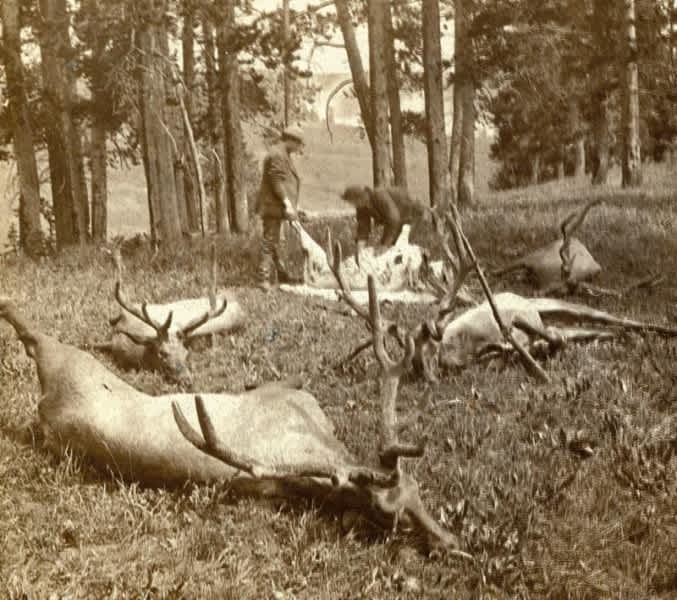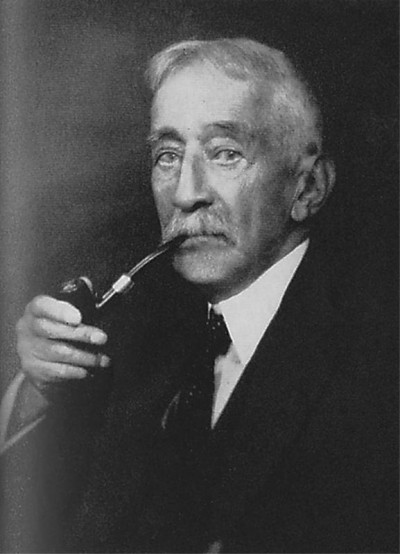Yellowstone Plundered by Market Hunters
Boone and Crockett Club 09.19.14

Soon on newsstands in all 38 states, an upcoming edition of “Forest and Stream” will feature a report by editor George Bird Grinnell on a poaching crisis still plaguing Yellowstone even in its fourth year as a U.S. national park.
Grinnell, back from an expedition in the area, witnessed the sad carnage and writes, “It is estimated that during the winter of 1874-1875, not less than 3,000 buffalo and mule deer suffer even more severely than the elk, and the antelope nearly as much.”
The concerned editor is urging Congress to help stop the rampant market hunting and exploitation of wildlife, timber, geysers and other natural resources of the park.
That’s how early sportsmen might have announced the launch of a long crusade that would change the course of conservation in America.
The plight of Yellowstone and the public outcry that followed Grinnell’s articles on what he called “the park grab,” proved to be a tipping point that rallied the 1887 formation of the Boone and Crockett Club. Founder Theodore Roosevelt was resolute in establishing the fledgling outfit’s first order of business: Protect the park.
Today, Boone and Crockett is commemorating the 120th anniversary of the Club’s first major success, the Yellowstone Protection Act of 1894.
“The campaign to preserve Yellowstone was the first time a natural resource issue secured the popular support of both sportsmen and non-sportsmen,” said current Boone and Crockett Club President Bill Demmer. “Yellowstone thrust Boone and Crockett into the national limelight as an organization of hunters leading America’s early conservation movement.”
The Yellowstone Protection Act was introduced and pushed through Congress by Boone and Crockett member John F. Lacey. The senator from Iowa is remembered more for his Lacey Act of 1900, which outlawed interstate commerce in wildlife and established authority for enforcement, effectively ending an era of indiscriminate slaughter through commercial market hunting. That law remains a cornerstone of conservation law. But Lacey also was an enthusiastic supporter of Yellowstone. He was disgusted by reports of market hunters savaging the park’s big-game populations.
Lacey’s 1894 act established Yellowstone as an inviolate wildlife refuge, the first in the country, and it provided for armed law enforcement. It was the first law establishing definitive national park management rules and it was also the first federal wildlife protection law. It was, and still is, considered landmark legislation.

“Although Congress and President Grant had designated Yellowstone as a national park in 1872, there were no clear laws or provisions for enforcement or prosecution for another 22 years,” explained Demmer. “Dubbed ‘America’s Playground,’ citizens had their first national park. They just didn’t know what to do with it or what that meant. Exploiters had free reign and the park’s resources remained in peril until the Yellowstone Protection Act in 1894.”
Grinnell, who would join Roosevelt in co-founding the Boone and Crockett Club, became editor of “Forest and Stream” in 1876. He used the “power of the pen” to take on commercial wildlife markets, timber barons, railroads and others who exploited the park.
Nevertheless, by 1886, poaching, vandalism, logging and theft had increased. The Northern Pacific Railroad also was plying for a new route through the heart of the park.
Another Boone and Crockett member, Gen. Philip Sheridan, who commanded U.S. military forces in the West, dispatched troops to protect Yellowstone.
Sheridan also suggested expanding park boundaries to conform with seasonal migration patterns of wildlife, an idea that met heavy opposition from lawmakers who felt Yellowstone was already too big.
Politicians also were reluctant to appropriate additional funds for the park. According to Yellowstone documentarian Ken Burns, lawmakers were frustrated over “a series of inept park superintendents including one who removed an entire geyser cone for shipment to the Smithsonian and proposed that a distinctive rock formation be equipped with plumbing so it could project a column of water to any desired height.”
These were the kinds of stories that Grinnell used to enflame the public.
Roosevelt, Grinnell, Lacey and Sheridan were joined by other club members, George G. Vest, Arnold Hague, William Hallett Phillips, W.A. Wadsworth and Archibald Rogers to name a few, in pushing for the Yellowstone Protection Act.
“Even 120 later, this group effort remains a point of pride for our club. It helped protect natural resources, minerals, geothermal features and the very landscape of America’s first national park – and it galvanized America’s trust in hunters as true leaders in wildlife conservation,” said Demmer.
He added, “Sadly, for the millions of visitors to Yellowstone each year, there is not one plaque or sign acknowledging sportsmen for saving the park. Maybe someday.”
For details about the Boone and Crockett Club’s legacy in Yellowstone, click here.
Contact
Steve Wagner, Blue Heron Communications, 800-654-3766 or steve@blueheroncomm.com

